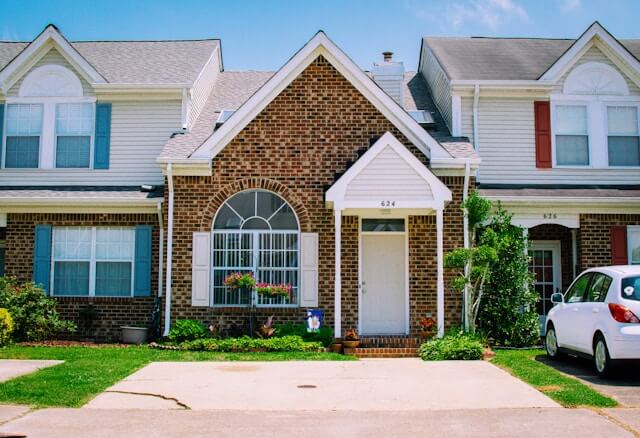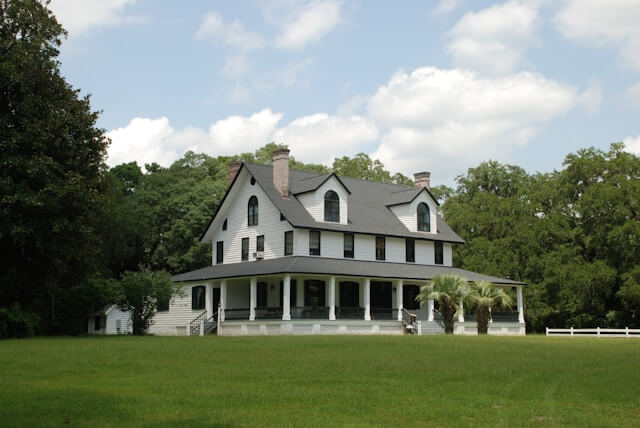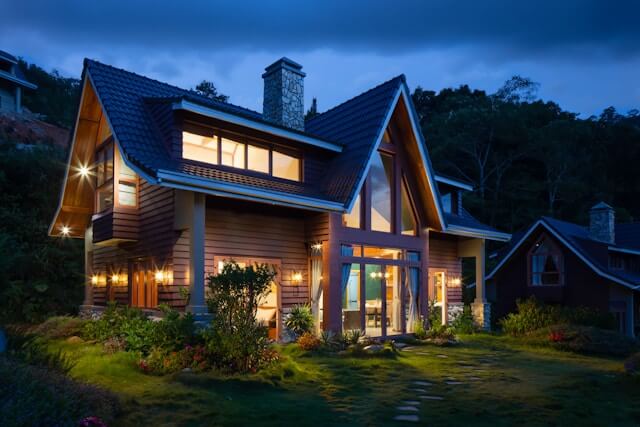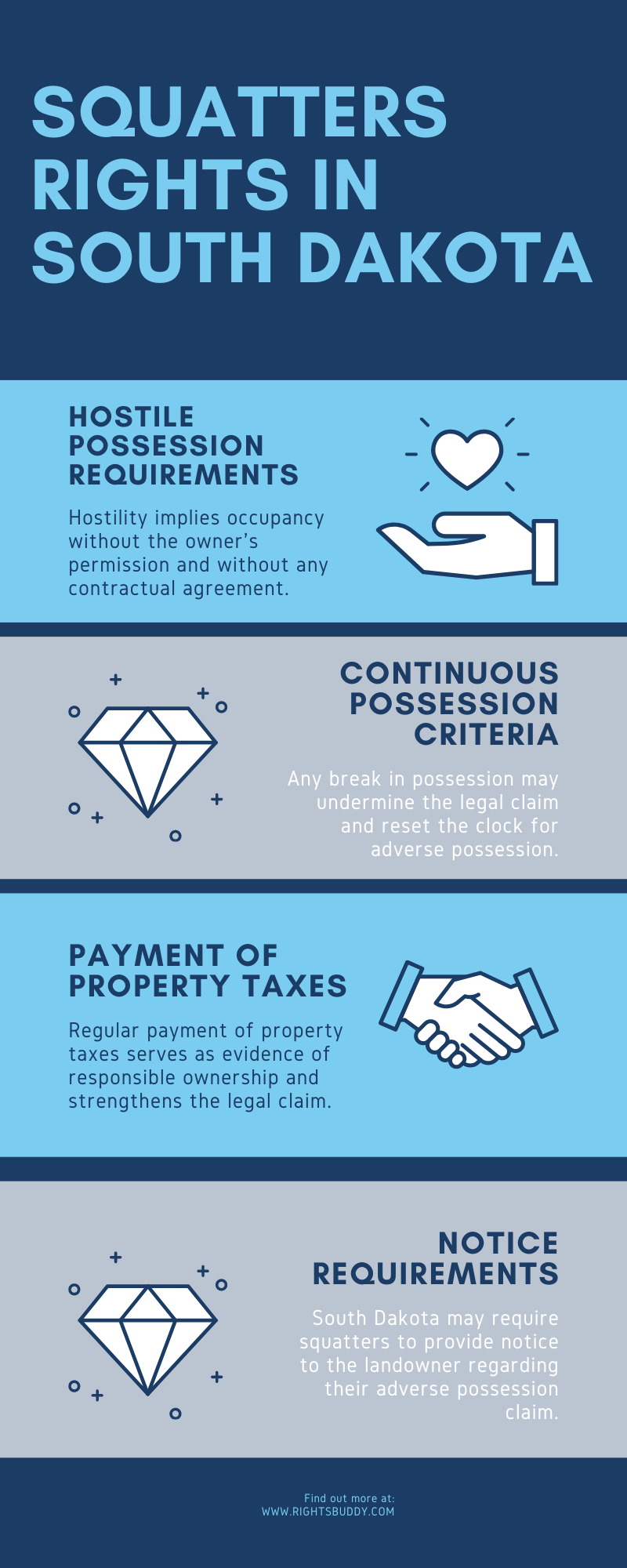Squatters Rights South Dakota – Everything you need to know!

Have you ever wondered about the squatting laws in South Dakota? Do squatters have rights in South Dakota? South Dakota does have laws regarding squatters’ rights, and it’s important to understand these laws to protect your property from potential squatting situations.
So, how can you avoid squatters in South Dakota? There are several precautions you can take to protect your property from potential squatters. Making sure your property is well-maintained and secure can help deter squatters from attempting to inhabit your property.
In our upcoming blog article, we’ll share valuable tips and information on dealing with squatters in South Dakota. We’ll discuss adverse possession claims, how to get rid of squatters, and other important factors to consider when dealing with squatting situations. Stay tuned for practical advice and insights on this important topic.

What are Squatters Rights in South Dakota
When it comes to property laws in the South Dakota, squatters rights are an important and often misunderstood concept. This article aims to clarify what squatters rights are and how they apply in the South Dakota.
Understanding Squatters Rights
Squatters rights, also known as adverse possession, refer to the legal principle that allows a person to claim ownership of a property if they have openly and continuously occupied it for a certain period of time, without the permission of the owner.
Requirements for Adverse Possession
In South Dakota, the requirements for adverse possession include open and notorious possession of the property for at least 15 years. This means that the squatter must openly occupy the property without trying to hide their presence, and the occupation must be continuous for the entire 15-year period.
Actions of the Property Owner
During the 15-year period, the property owner must not take any legal action to remove the squatter from the property. If the property owner attempts to evict the squatter within the 15-year period, the clock on the adverse possession claim may be reset, and the squatter will have to start the 15-year requirement again.
Proving Adverse Possession
To prove adverse possession in South Dakota, the squatter must provide evidence that they have met all the requirements, including open and continuous occupation of the property for 15 years. This can include witness testimony, photographs, and other forms of documentation that demonstrate their claim to the property.
Consulting with Legal Professionals
If you are involved in a squatters rights situation in South Dakota, it is essential to seek legal advice from experienced attorneys who specialize in real estate law. They can provide guidance on how to proceed with an adverse possession claim and help navigate the complex legal process.

Squatting vs. Trespassing in South Dakota
Squatting is the act of unlawfully occupying an uninhabited building or unused land without the owner’s permission.
While Trespassing, on the other hand, is entering someone else’s property without authorization or staying on the property after being asked to leave.
Defining Squatting and Trespassing
Squatting refers to the act of residing in a property without the owner’s permission or legal right to do so. This can involve occupying an abandoned building, unused land, or even an empty home. Trespassing, on the other hand, is the act of entering another person’s property without authorization.
Difference between Squatting and Trespassing
The key difference between squatting and trespassing lies in the intent of the individual. Squatters typically aim to establish long-term residence in the property, while trespassers may only be on the property temporarily without any intention of making it their home.
Penalties for Squatting and Trespassing in South Dakota
In South Dakota, the penalties for squatting and trespassing can vary depending on the circumstances. Squatting can result in civil and criminal penalties, including eviction and potential criminal charges if the individual refuses to vacate the property.
To avoid legal issues related to squatting and trespassing in South Dakota, it is essential for individuals to respect property rights and obtain proper authorization before entering or residing on a property.
By understanding the definitions and differences between squatting and trespassing, individuals can make informed decisions and avoid potential legal consequences in South Dakota.
How Do Squatters Claim Adverse Possession in South Dakota
Adverse possession is a legal doctrine that allows individuals to gain ownership of land they do not have legal title to by occupying it openly, notoriously, and continuously for a specified period of time.
In South Dakota, squatters can claim adverse possession by meeting specific legal requirements.
Understanding Adverse Possession
Adverse possession is a legal concept that allows a person to claim ownership of land that is not legally theirs, through continuous and open possession of the land for a certain period of time.
In South Dakota, the statutory period for adverse possession is 20 years, during which the squatter must occupy the land without the permission of the true owner.
The Requirements for Adverse Possession in South Dakota
In order to claim adverse possession in South Dakota, the squatter must meet several requirements. They must show that their possession of the land is actual, open, notorious, exclusive, hostile, and continuous for the entire statutory period.
The Process of Filing for Adverse Possession
To initiate a claim for adverse possession in South Dakota, the squatter must file a lawsuit in the circuit court of the county where the land is located. They must provide clear evidence of their continuous and open possession of the land for the statutory period.
The court will then determine whether the squatter meets all the requirements for adverse possession and has a valid claim to ownership of the land.
Evicting Squatters in South Dakota: How to Get Rid of Squatters in South Dakota
In South Dakota, squatters have certain rights, including the right to due process and the right to a hearing before they can be evicted.
This means that you cannot simply throw squatters out of your property without following the proper legal procedures.
1. Who is a Squatter?
A squatter is a person who occupies a property without the owner’s permission. Squatters can be difficult to remove, as they often have no legal right to the property and may refuse to leave.
2. What are the Laws Governing Squatters in South Dakota?
South Dakota law defines a squatter as a person who occupies a property without the owner’s permission for more than 30 days. Squatters can be evicted through a legal process called an unlawful detainer action.
3. What is an Unlawful Detainer Action?
An unlawful detainer action is a legal proceeding in which a landlord seeks to evict a squatter from a property. The landlord must file a complaint with the court, which will then issue a summons to the squatter.
The squatter has a certain amount of time to respond to the summons, and if they fail to do so, the court may enter a default judgment against them.
4. What Happens After a Default Judgment is Entered?
If a default judgment is entered against the squatter, the landlord will be awarded possession of the property. The landlord can then have the squatter removed from the property by a sheriff or other law enforcement officer.
5. What if the Squatter Refuses to Leave?
If the squatter refuses to leave the property after a default judgment has been entered, the landlord can file a motion for a writ of possession. The court will then issue a writ of possession, which orders the sheriff to remove the squatter from the property.

How to Protect Your Property from Squatters in South Dakota
Squatting is the unlawful occupation of a property by a person who does not have the owner’s permission. Squatters can cause a lot of damage to your property, and they can be difficult to remove. If you are a property owner in South Dakota, there are a few things you can do to protect your property from squatters.
1. Secure Your Property
The best way to prevent squatters from occupying your property is to make it difficult for them to get in. This means securing all of your doors and windows, and installing a security system. You should also keep your property well-maintained, as squatters are more likely to target properties that appear to be abandoned.
2. Post No Trespassing Signs
Posting no trespassing signs around your property is another way to deter squatters. These signs should be placed in conspicuous locations, and they should state that trespassing is prohibited. You can also post signs that say that the property is under video surveillance.
3. Keep an Eye on Your Property
One of the best ways to prevent squatters from occupying your property is to keep an eye on it. This means regularly inspecting your property for signs of squatting, such as broken windows, graffiti, or piles of trash. If you see any signs of squatting, you should contact the police immediately.
4. Evict Squatters Legally
If squatters have already occupied your property, you will need to evict them legally. This can be a complex and time-consuming process, so it is important to seek legal advice from an attorney.
In South Dakota, you can evict squatters by filing a complaint with the magistrate court. The court will then issue an order requiring the squatters to vacate the property.
5. Take Legal Action Against Squatters
If squatters refuse to leave your property after you have obtained a court order, you may need to take legal action against them. This could include filing a lawsuit for damages or seeking an injunction to prevent them from returning to your property. You may also be able to recover attorney’s fees and other costs.
How Much Does it Cost to Evict a Squatter in South Dakota
Evicting a squatter in South Dakota can be a costly and time-consuming process. The total cost of eviction will vary depending on the specific circumstances of the case, but there are some general costs that you can expect to incur.
| Expense | Estimated Cost | Comments |
|---|---|---|
| Filing Fee | $70 – $95 | Payable to the court when filing the eviction notice. Prices may vary by county. |
| Service of Process | $40 – $70 | Cost of serving the eviction notice to the squatter by the sheriff or process server. |
| Attorney Fees | $500 – $2000+ | This can vary widely depending on the complexity of the case and the attorney’s rates. |
| Locksmith | $75 – $150 | If you need to change locks after evicting the squatter. |
| Lost Rent | Varies | Potential lost income calculated by the duration the squatter occupies the property. Not a direct cost but an economic loss. |
| Additional Court Costs | Varies | Possible additional costs if the squatter contests the eviction and there are further court proceedings. |
| Damages/Repairs | Varies | Cost to repair any damages the squatter may have caused to the property. |
Legal Fees
The most significant cost associated with evicting a squatter is typically legal fees. You will need to hire an attorney to represent you in court and to file the necessary paperwork. The cost of legal fees will vary depending on the complexity of the case and the experience of the attorney you hire. However, you can expect to pay several thousand dollars in legal fees.
Court Costs
In addition to legal fees, you will also need to pay court costs. These costs can include filing fees, service of process fees, and witness fees. The amount of court costs you will be responsible for will vary depending on the court in which the case is filed.
Other Costs
There may also be other costs associated with evicting a squatter, such as the cost of boarding up the property or the cost of removing the squatter’s belongings. These costs can vary depending on the specific circumstances of the case.
If you are considering evicting a squatter, it is important to be aware of the potential costs involved. You should consult with an attorney to discuss your specific situation and to get an estimate of the total cost of eviction.
How To Claim Squatters Rights In South Dakota
To successfully claim squatters’ rights in South Dakota, you must meet specific legal requirements known as adverse possession.
What Are Squatters Rights?
Squatters rights, also known as adverse possession, is a legal doctrine that allows a person to claim ownership of real property by occupying it for a certain period of time, openly, notoriously, exclusively, and continuously. In South Dakota, the adverse possession period is 10 years.
Who Can Claim Squatters Rights?
To claim squatters rights in South Dakota, you must be:
- In actual possession of the property.
- Open and notorious in your possession.
- Exclusive in your possession.
- Continuous in your possession for 10 years.
What Does It Mean To Be In Actual Possession?
To be in actual possession of the property, you must physically occupy it. This means living on the property, using it for agricultural purposes, or otherwise exercising control over it.
What Does It Mean To Be Open and Notorious in Your Possession?
To be open and notorious in your possession, you must make it clear to others that you are claiming the property as your own. This can be done by posting signs, paying taxes on the property, or making improvements to the property.
What Does It Mean To Be Exclusive in Your Possession?
To be exclusive in your possession, you must be the only person who is using the property. This means that you cannot share the property with anyone else, including the legal owner.
If you meet all of these requirements, you may be able to claim squatters rights in South Dakota. However, it is important to note that the process of claiming squatters rights can be complex and time-consuming. It is advisable to consult with an attorney before attempting to claim squatters rights.
FAQs about Squatters Right in South Dakota
Here are some of the most asked questions.
What are squatter’s rights in South Dakota?
Squatter’s rights, also known as adverse possession, allow a person to claim ownership of land that they have occupied and used openly, notoriously, exclusively, and continuously for a specific period of time, typically 10 years in South Dakota.
What are the requirements for establishing squatter’s rights in South Dakota?
To establish squatter’s rights in South Dakota, a person must meet the following requirements:
- Open and notorious possession: The possession must be visible and apparent to the public, such as living on the land, cultivating it, or building structures.
- Exclusive possession: The possession must be exclusive, meaning that no one else is using or claiming ownership of the land.
- Continuous possession: The possession must be continuous for the required period of time, typically 10 years in South Dakota.
- Hostile possession: The possession must be hostile, meaning that it is not with the permission of the true owner.
- Payment of taxes: The squatter must pay all property taxes on the land during the possession period.
How long does it take to establish squatter’s rights in South Dakota?
The time required to establish squatter’s rights in South Dakota is typically 10 years. However, this period can be shortened to 5 years if the squatter makes substantial improvements to the land, such as building a house or barn.
What are the defenses to a squatter’s rights claim in South Dakota?
There are several defenses that a landowner can assert against a squatter’s rights claim in South Dakota, including:
- Lack of possession: The landowner can argue that the squatter did not meet the requirements for possession, such as by not occupying the land openly and notoriously.
- Permission to occupy: The landowner can argue that the squatter occupied the land with the landowner’s permission, which would negate the element of hostility.
- Break in possession: The landowner can argue that the squatter’s possession was interrupted, such as by the landowner retaking possession of the land.
- Estoppel: The landowner can argue that the squatter is estopped from claiming ownership of the land, such as by accepting rent payments from the squatter.
What are the consequences of establishing squatter’s rights in South Dakota?
If a squatter successfully establishes squatter’s rights in South Dakota, they will gain legal ownership of the land. This means that they will have the right to possess, use, and sell the land as they see fit.
Conclusion: Squatters Right in South Dakota
We have discussed “What are Squatting Laws in South Dakota? Do squatters have rights in South Dakota?” We have learned that South Dakota recognizes adverse possession as a way for squatters to gain legal title to property.
Adverse possession requires the squatter to occupy the property openly, notoriously, exclusively, and continuously for a period of 10 years.We also talked about “How to avoid squatters in South Dakota?”
We have learned that there are a few things you can do to avoid squatters, such as posting “No Trespassing” signs, keeping the property well-maintained, and checking the property regularly.
Related:
Squatters Rights U.S. Virgin Islands – Everything you need to know!
